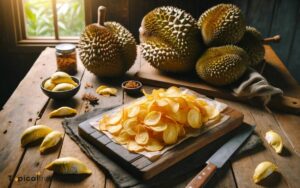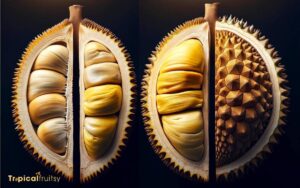Does Durian Grow on Trees? Yes!
Yes, durian does grow on trees. The durian, known as the ‘King of Fruits’, is a tropical fruit that grows on the Durio species of trees within the Malvaceae family.
These trees are native to Southeast Asia and can reach heights of 25 to 50 meters. Durian trees are characterized by their large, spiky fruits with a strong aroma and are a staple in the regions where they are grown.
The durian tree thrives in tropical climates that are hot and humid, typically found in countries like Thailand, Malaysia, and Indonesia.
Here are some key points about durian trees:
These trees require specific conditions to flourish, including ample sunlight and plenty of rainfall.
The fruit, with its notorious smell and large size, is polarizing; some people love it for its unique taste, while others are put off by its strong odor.
Durian trees produce a fruit that is as notorious for its pungent aroma as it is celebrated for its rich, custard-like flavor.
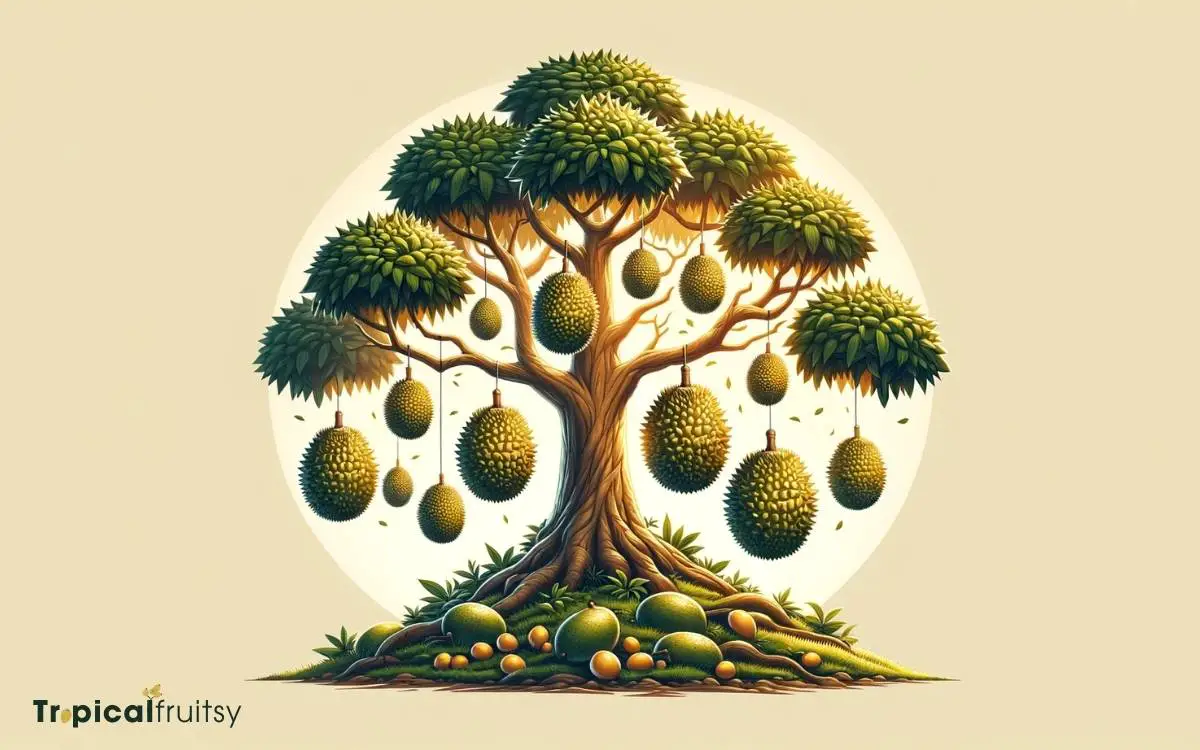
Key Takeaway
Durian Tree Information: A Guide to the King of Fruits
| Characteristic | Description |
|---|---|
| Scientific Name | Durio spp. |
| Family | Malvaceae |
| Native Region | Southeast Asia |
| Preferred Climate | Tropical and humid |
| Soil Requirements | Rich, well-drained |
| Average Tree Height | 25 to 50 meters |
| Age to Bear Fruit | 4 to 5 years |
| Pollination | Facilitated by bats, insects, and other animals |
| Fruit Characteristics | Large size, spiky husk, strong odor |
Unveiling the Durian Tree
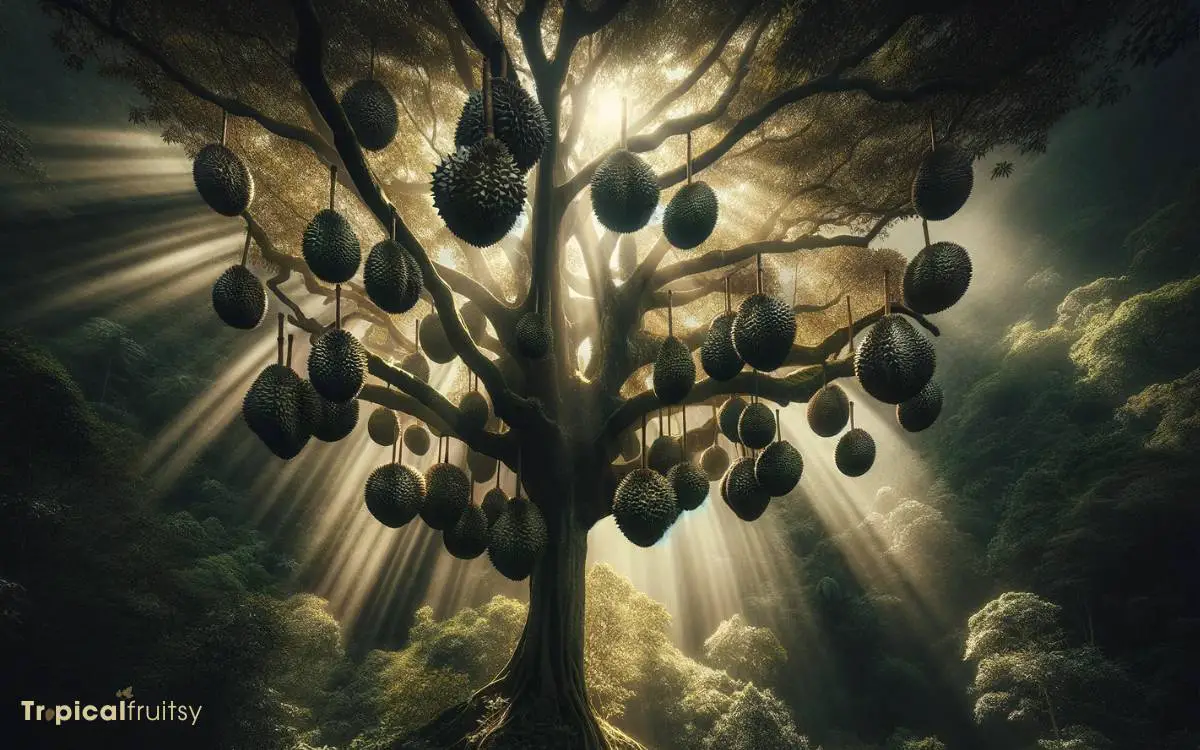
Every durian fruit originates from the sturdy branches of the Durian tree, a tropical species indigenous to Southeast Asia.
Scientifically known as Durio, this genus comprises approximately 30 species, though only a few are utilized for consumption.
The most cultivated species, Durio zibethinus, is renowned for its sizeable, odorous fruits that elicit strong reactions due to their potent aroma.
These trees are large, reaching heights of up to 50 meters in their native rainforest habitat with a straight trunk and a broad, irregular crown. The leaves are evergreen, elliptical, and glossy, providing a verdant canopy throughout the year.
The durian tree’s flowers, which are pollinated by bats and certain birds, are large and white, blooming directly on the branches and trunk—a phenomenon known as cauliflory.
Understanding Durian Botany
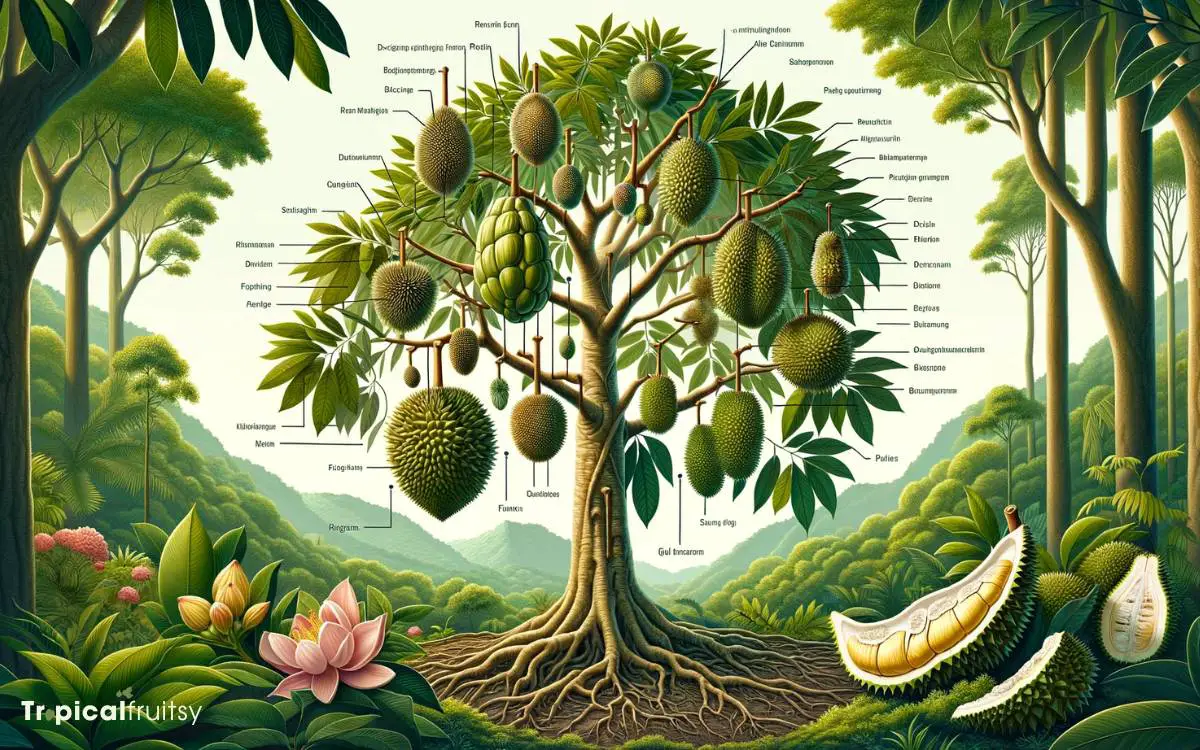
The durian, a unique and complex fruit, develops from the flowers of its namesake tree following a fascinating process of pollination and growth.
The hermaphroditic flowers of the Durio genus are primarily pollinated by bats, a process central to the tree’s reproductive success. Once pollination occurs, the flowers undergo a transition, ultimately resulting in the durian fruit.
To elucidate the stages of durian development, consider the following table:
| Stage | Description | Duration |
|---|---|---|
| Flowering | Bud emergence to full bloom | 2-4 days |
| Pollination | Transfer of pollen to stigma | 1 night |
| Fruit Set | From pollination to young fruit | 2-3 weeks |
| Fruit Development | Fruit enlargement and maturation | 3-5 months |
| Ripening | Physiological changes for edibility | 3-7 days |
This progression from flower to fruit embodies the complexity of durian botany, highlighting the meticulous orchestration of biological processes that lead to the formation of the world’s most controversial fruit.
The Durian Life Cycle
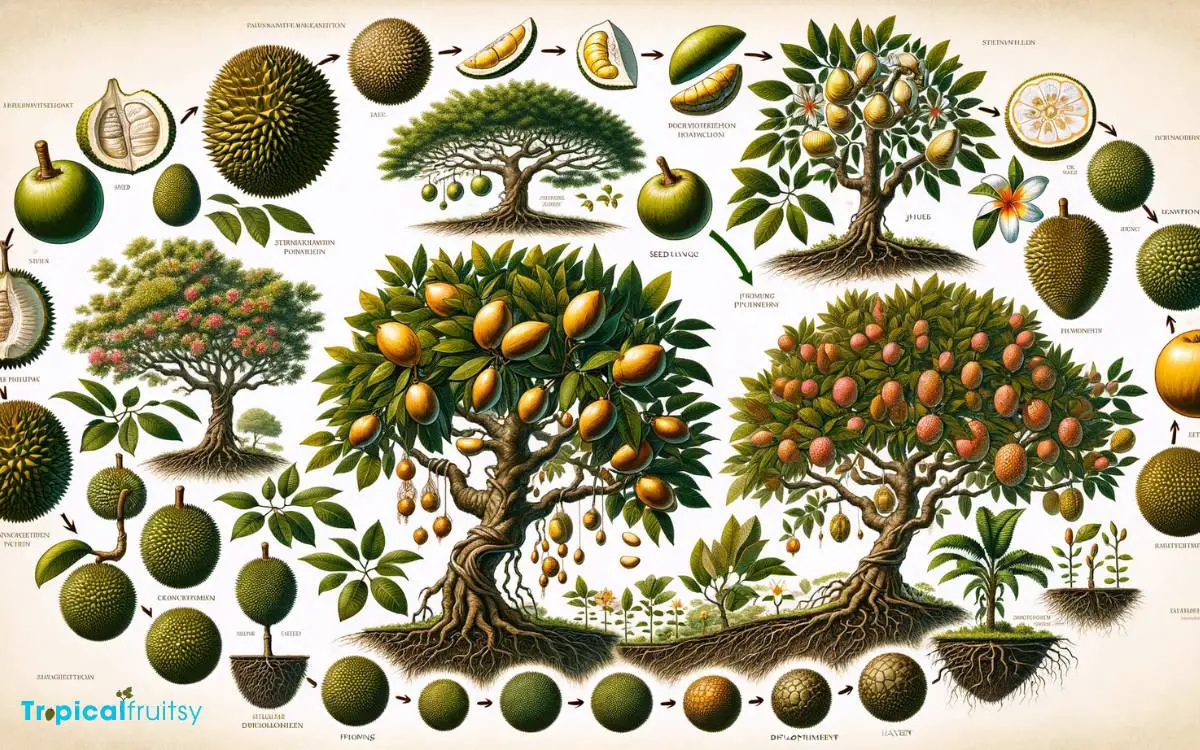
How does the lifecycle of a durian progress from the initial flowering to the ultimate drop of its heavy fruits?
The durian tree (Durio spp.) begins its reproductive phase by producing a profusion of large, white to yellowish flowers, which are pollinated by bats and certain insects nocturnally.
Following successful pollination, the flowers develop into young fruits over a period of approximately three to four months.
These fruits undergo a maturation phase where they enlarge and their husks harden, usually taking another two to three months.
As the durian achieves full maturity, biochemical changes signal the ripening process, which climaxes in the fruits’ natural detachment from the tree.
Harvesting the King of Fruits
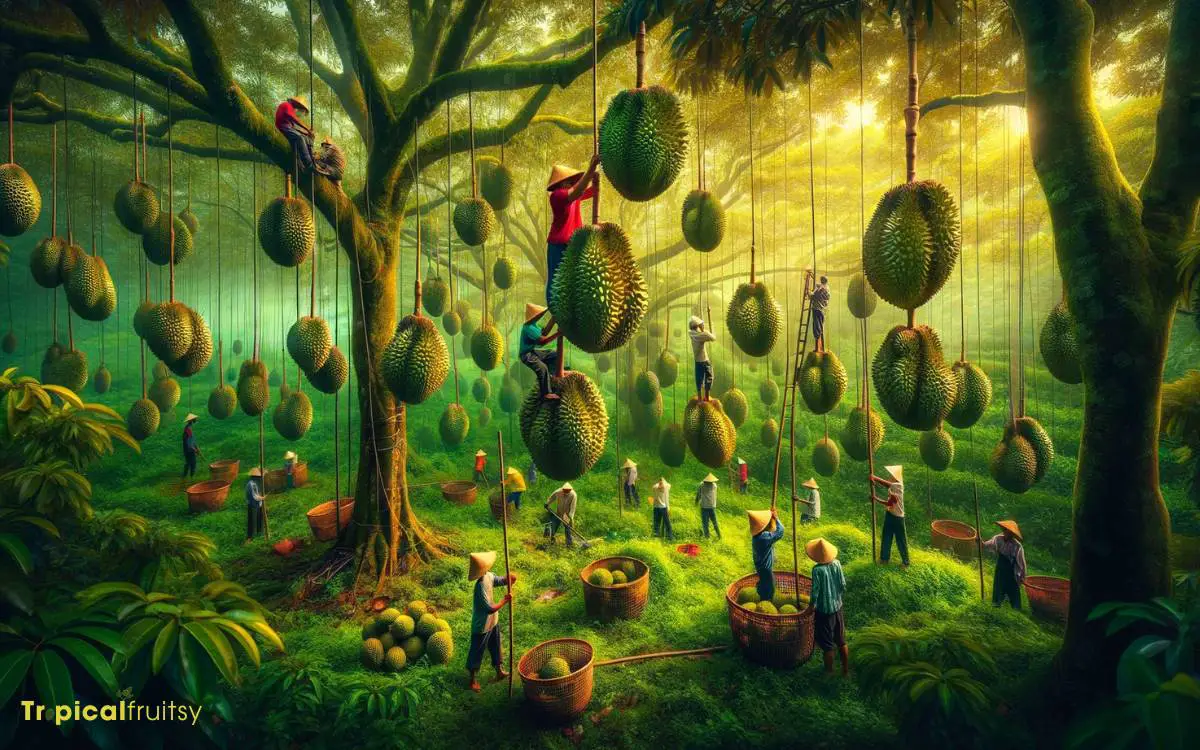
Upon reaching full maturity, durian fruits are typically harvested either by collecting them after a natural fall or by careful handpicking to prevent damage.
The timing of the harvest is critical and is determined by observing the color change and yielding to slight pressure.
Professional harvesters often use specialized tools, such as long poles with nets or pruners, to reach the high branches and carefully lower the fruits to the ground. This minimizes the risk of bruising the fruit’s flesh, which can significantly affect its market value.
After harvesting, the fruits undergo a period of post-harvest ripening, during which their distinctive aroma intensifies.
Cultivating Durian Trees
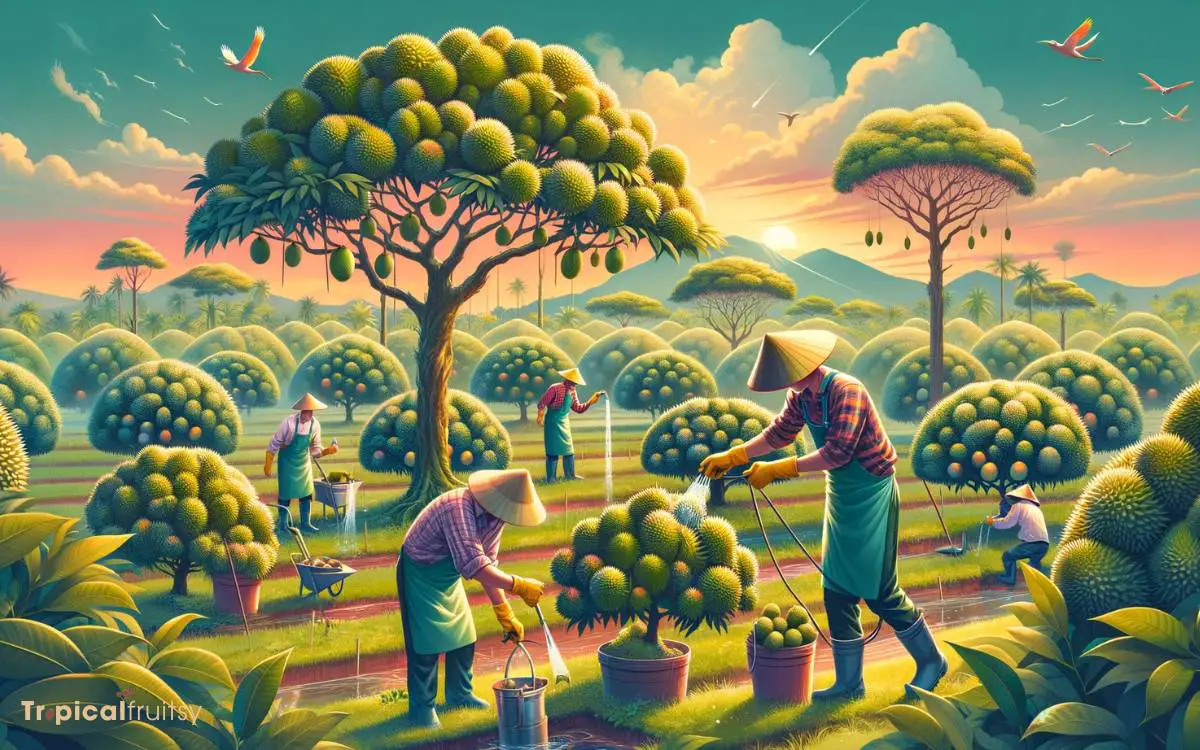
Cultivating durian trees necessitates a comprehensive understanding of the specific horticultural conditions they require.
The ideal soil for durian cultivation is well-drained, fertile, and rich in organic matter, with a pH range between 6 and 7.
Additionally, these trees thrive in tropical climates, demanding consistent temperatures ranging from 24°C to 30°C and high humidity levels.
Ideal Soil Conditions
Regarding the cultivation of durian trees, optimal soil conditions include well-drained, fertile loam with a high organic matter content and a pH range of 6 to 7.
These parameters are crucial for the root system to develop properly and for ensuring adequate nutrient uptake, which is essential for the growth and fruiting of durian trees.
| Soil Property | Ideal Condition |
|---|---|
| Texture | Fertile loam |
| Drainage | Well-drained |
| Organic Matter | High content |
| pH Level | 6 to 7 |
| Nutrient Availability | Adequate for growth |
Soil fertility is enhanced by the presence of organic matter, which also improves soil structure and water retention.
A pH within the slightly acidic range is favorable for durian cultivation, as it affects nutrient availability and root growth.
Climate Requirements
Durian trees typically require a tropical climate with consistent rainfall and high humidity to produce fruit successfully.
These conditions are crucial as they directly influence the physiological processes of the tree, such as photosynthesis, transpiration, and nutrient uptake.
Here are the specific climate requirements for durian cultivation:
Temperature:
- Optimal range: 24°C to 30°C
- Minimum tolerance: About 22°C
Rainfall:
- Annual requirement: 1,500 to 3,000 mm
- Evenly distributed throughout the year
Humidity:
- Ideal relative humidity: 75% to 80%
- Ensures adequate moisture for flower and fruit development
Understanding these requirements is essential for successful cultivation.
Durian Varieties and Habitats
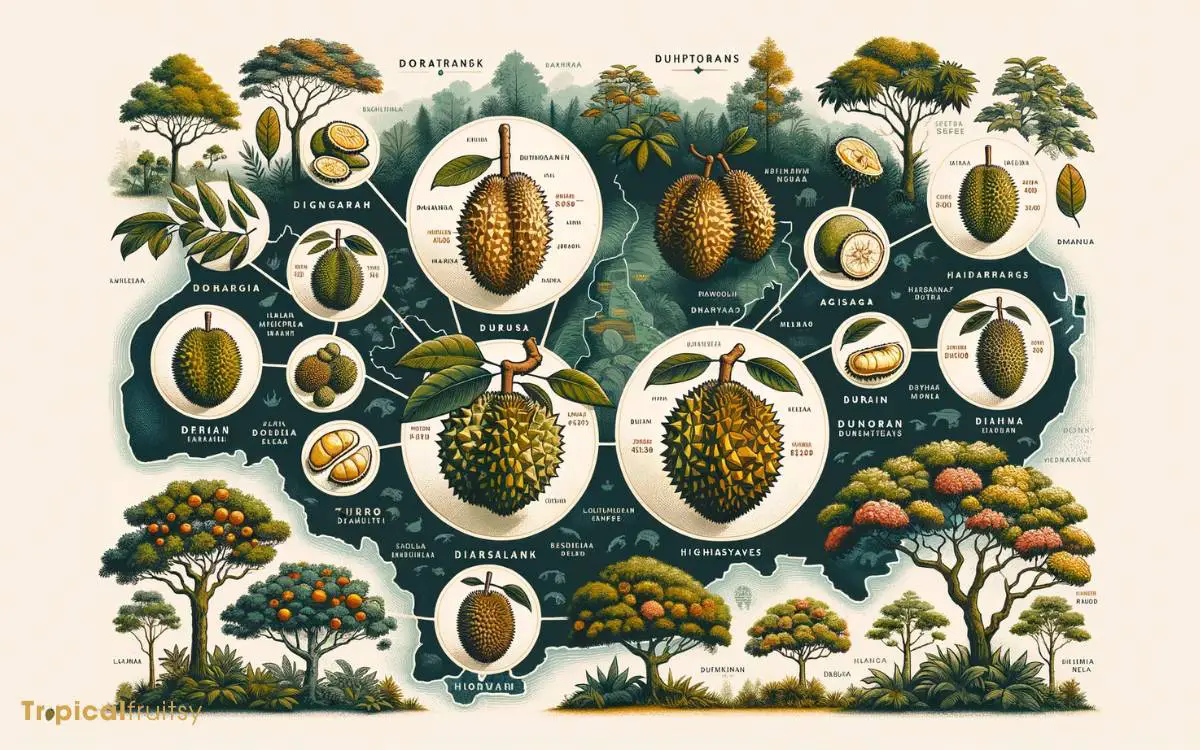
Durian trees (Durio spp.), known for their distinctive fruit with a pungent aroma, encompass a variety of cultivars each with unique flavor profiles that cater to diverse palates.
These cultivars have adapted to specific habitats, with the majority thriving in the equatorial climates of Southeast Asia, particularly in countries like Malaysia, Thailand, and Indonesia.
Understanding the relationship between cultivar characteristics and their native growing regions is essential for both cultivation and conservation efforts.
Cultivar Flavor Profiles
We must note that durian trees, depending on the cultivar, yield fruits with a diverse range of flavors that are significantly influenced by their native habitats.
The chemical composition of the soil, climate conditions, and specific horticultural practices contribute to the distinctive flavor profiles of each variety.
To elucidate:
Musang King (Malaysia)
- Rich and creamy
- Notes of caramel and a bitter-sweet aftertaste
Monthong (Thailand)
- Mild and sweet
- Texturally buttery with a more subdued odor
Red Prawn (Penang, Malaysia)
- Sweet and complex
- Hints of citrus and a fine, creamy texture
Each cultivar presents unique organoleptic properties, with aficionados often preferring one over another based on these nuanced differences. Understanding these profiles aids consumers in selecting a fruit that aligns with their taste preferences.
Native Growing Regions
Spanning across Southeast Asia, durian trees thrive in diverse climates and soils, each region cultivating varieties that are uniquely adapted to local environmental conditions.
These regions range from lowland rainforests to highland areas, with the specific geographic and climatic conditions influencing the characteristics of the durian varieties found therein.
| Region | Durian Variety Characteristics |
|---|---|
| Thailand | Thick flesh, mild sweetness |
| Malaysia | Intense flavor, creamy texture |
| Indonesia | Varied tastes, smaller size |
The durian tree, Durio zibethinus, is typically found in equatorial regions where the climate provides a consistent temperature range conducive for its growth. These areas, with high humidity and ample rainfall, offer ideal habitats for durian cultivation.
Scientific analysis of soil composition, local flora, and climate patterns has facilitated the development of durian cultivars with optimized traits for each region’s unique ecosystem.
How Long Does Durian Take to Grow
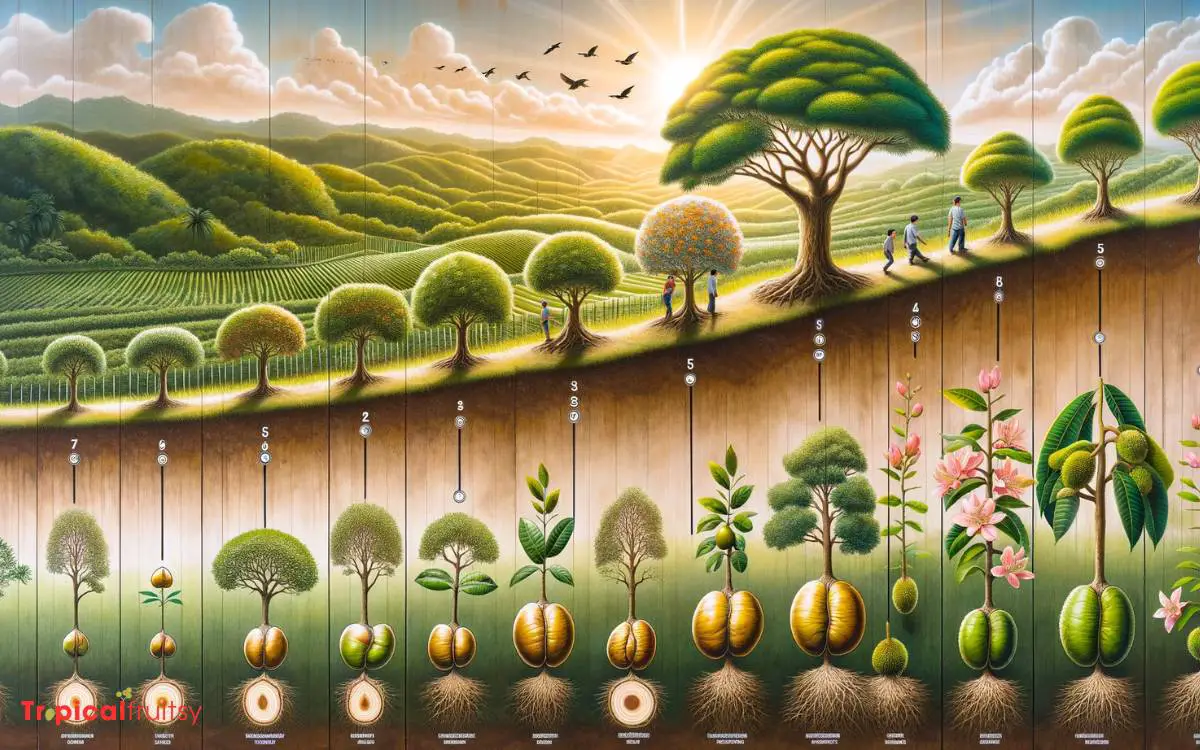
Durian trees, known for producing the distinctive durian fruit, have a significant growth and maturation period.
Here’s an overview of their growth timeline:
- Seed Germination: Durian seeds typically take about 2 to 7 days to germinate after being planted.
- Sapling Stage: After germination, the sapling stage can last several months to a few years as the tree establishes itself.
- Juvenile Phase: The juvenile phase of a durian tree can last for about 5 to 7 years. During this time, the tree grows but does not produce fruit.
- First Fruit Production: Durian trees typically begin to bear fruit around 5 to 7 years after planting, depending on the variety and growing conditions.
- Full Maturity: For a durian tree to reach full maturity and optimal fruit production, it can take anywhere from 10 to 15 years.
- Peak Fruit Production Years: Once mature, durian trees can remain productive for many years, often peaking in fruit production between 15 to 20 years of age.
It’s important to note that these timelines can vary based on factors like the durian variety, climate, soil conditions, and cultivation practices.
How Long Before Durian Tree to Bear Fruit
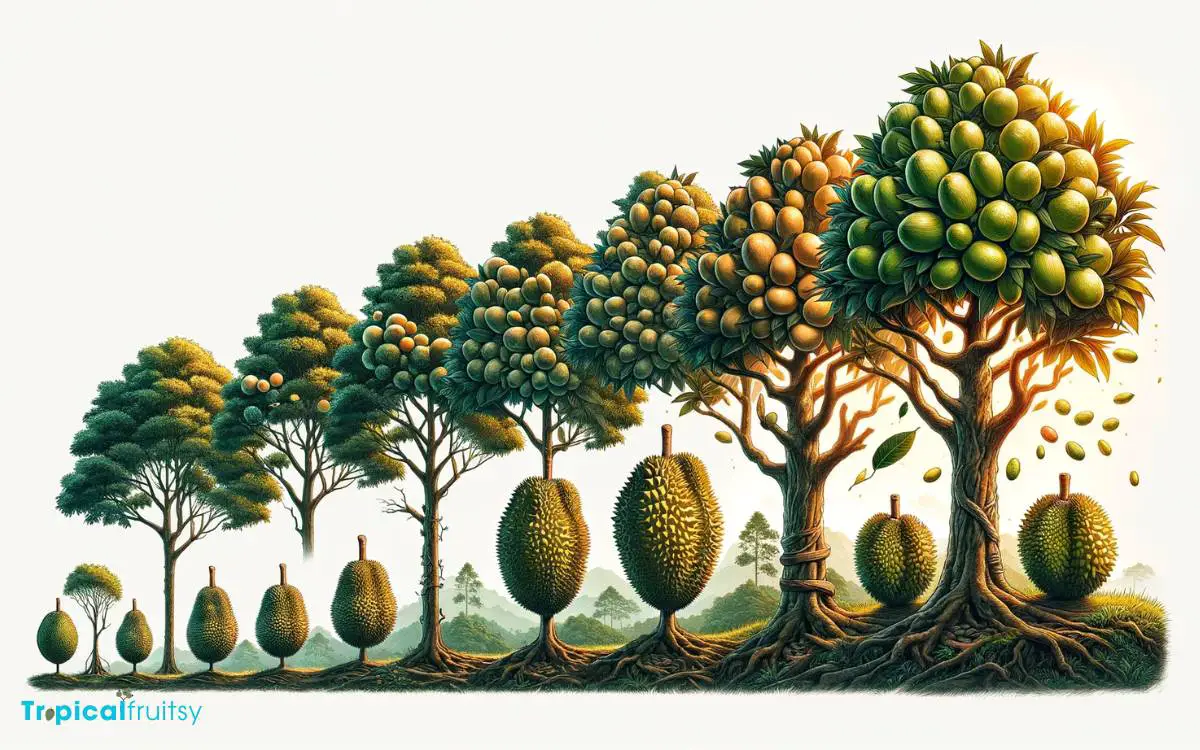
A durian tree generally takes about 5 to 10 years to start bearing fruit after planting. The exact time can vary based on factors such as the variety of durian, the growing conditions, and the care provided to the tree.
Some grafted varieties may bear fruit a bit earlier, while seed-grown trees often take longer. Proper fertilization, watering, and pest control can help in encouraging earlier and healthier fruit production.
How Tall Is Durian Tree
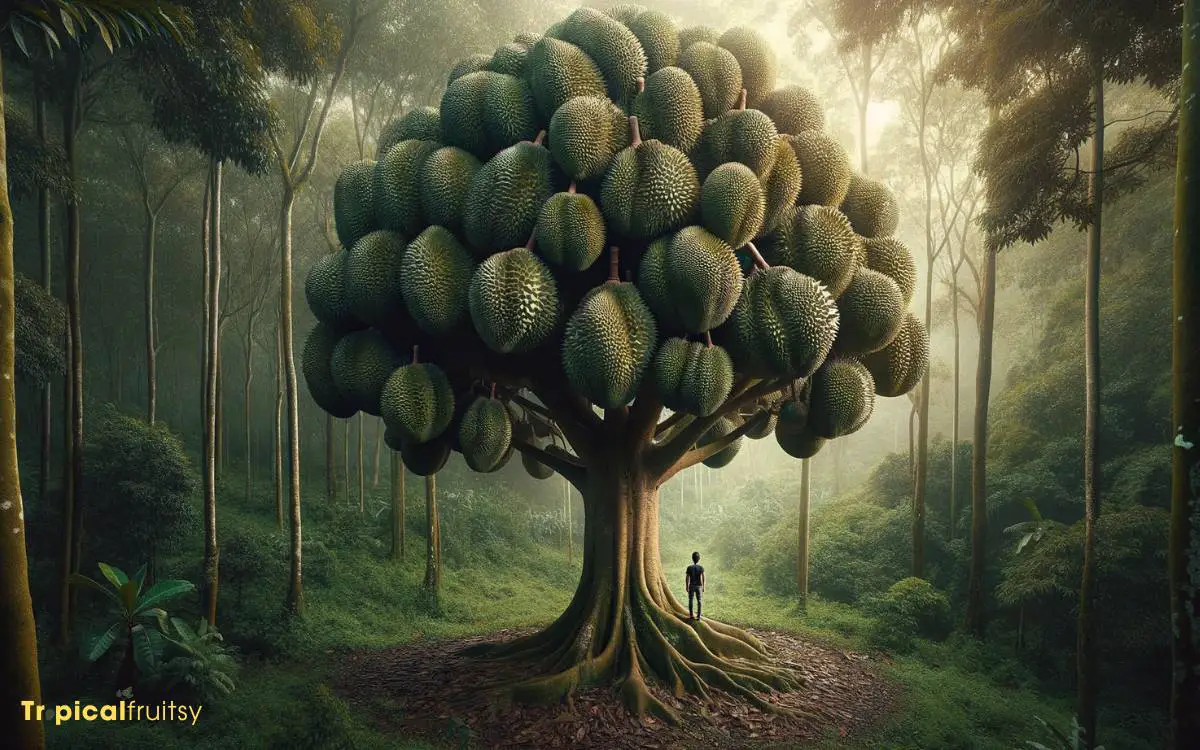
A durian tree can grow quite tall, typically reaching heights between 25 to 50 meters (about 80 to 165 feet). However, in cultivation, they are often kept shorter through pruning for easier harvesting.
This pruning is usually done to maintain them at a more manageable height of around 10 to 20 meters (approximately 30 to 65 feet).
The height of a durian tree can vary depending on the species, growing conditions, and care practices.
Conclusion
The durian, revered as the ‘King of Fruits,’ thrives on its namesake trees, yielding a bounty that polarizes palates worldwide.
As cultivation practices evolve and understanding of its unique botany deepens, one questions whether the appreciation for durians will expand or remain an exotic preference.
The complexities of durian varieties and their ecological niches underscore the fruit’s significance in both commerce and culture, reflecting the intricate relationship between humanity and the botanical world.


